
Wednesday September 22, 2004
FIGHT CLUB!
A comparison of 1/32 LMP models
BY ROB WESSLING
 Greetings
SLOT CAR FANS!!!! I've finally put pen to paper, and want to share with you a
club racers view of some of the latest offerings by 1/32 manufacturers. Many of
us are keen club racers, who find a lot of enjoyment racing these fine models
against fellow enthusiasts in local club competition. Some of us also collect
them (and that's fine too!), but for some, on-track performance is the key
selection criteria, PURE AND SIMPLE!
Greetings
SLOT CAR FANS!!!! I've finally put pen to paper, and want to share with you a
club racers view of some of the latest offerings by 1/32 manufacturers. Many of
us are keen club racers, who find a lot of enjoyment racing these fine models
against fellow enthusiasts in local club competition. Some of us also collect
them (and that's fine too!), but for some, on-track performance is the key
selection criteria, PURE AND SIMPLE!
I love LMP cars, both in 1:1 and in our hobby. They are generally one of the quicker styles of model available, made possible via the inherent stability of a generous track and wheelbase, a low centre of gravity and relatively light-weight. Many clubs run this class of car in regular competition, so I thought it would be appropriate to take a closer look at some of the more enticing cars currently out there in the marketplace.
I don't want to get into any scale issues in this comparison, I know and accept that some 1/32 models have problems in this area. From my personal viewpoint, the models mentioned here represent the prototype pretty darned accurately! I'm never going to get a chance to run a micrometer over the real ones, so it's all a little academic for me at this point in time.
Having said that, I DON'T THINK ANY OF THE MODELS SELECTED IN THIS REVIEW have any major issues in this area. They represent the ''CREAM'' of the current 1/32 manufacturers. All offer excellent fit, finish and Tampo. They are small works of art in their own right, exhibiting exquisite detail and great overall presentation. Our hobby is in great shape if my samples are anything to go by, an enthusiast would be proud to own any of them, THEY ARE ALL THAT GOOD. Not to say I didn't find a few very, very minor faults (a trapped spec of dust here, a minute Tampo fault there), but wow, these things are so crisp.
NOW, time to introduce the ''contenders'' for the 1/32 LMP crown!!!
Firstly the current champ (IMHO), the venerable Scalextric Lola MG. This model caused quite a stir when initially offered to enthusiasts, it was reasonably cheap, offered great out of the box performance (OOB) and looked a treat (possibly one of the prettiest 1/32 LMP cars of all time). It was soon realized by Die-hard enthusiasts that the MG Lola responded very well to hop-up parts, in particular, upgraded motors and silicone tires. Spend a little, gain a considerable performance increase, A GREAT CAR FOR THOSE ON A BUDGET!
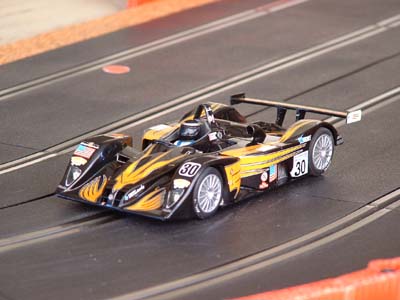
Next on the list of cars for this test is the latest from the Scalextric stable, the new (ish) Lister Storm SPORT LMP. With some mighty BIG shoes to fill, Scalextric decided to go all out with this model, basically it is a full revision of chassis design, incorporating many unique features. Without going into too much detail (Harry has done a fine job describing these changes fully in his review of the Scaley Lister Storm, its available for viewing in the HRW Review archives section), the model is equipped with the new style Scalextric front guide, a separate rear motor pod and quick dis-connect motor leads. It certainly offers some serious credibility, BUT can it knock its sibling from the top spot????
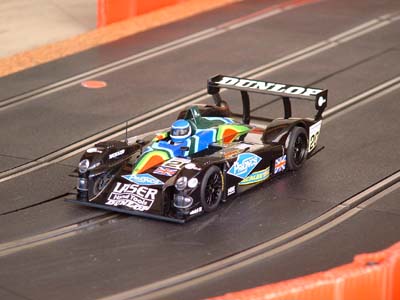
The DARK HORSE of the field, SCX's DOME JUDD LMP is an unpretentious model, aimed fairly and squarely at the "club racer". The advertising blurb boasts features such as ''racing quality'' pick-up braids, super soft rear rubber, and a neat motor pod assembly that gives the rear axle a degree of independent movement. It would be fair to say that I have been a critic of the SCX brand name in the past, but after reading some great things about this model, I thought it would be good to put aside prejudices and try one for myself. Over here in Oz, SCX models are dirt cheap and plentiful, they range in price from $37.00AUD to $42.00AUD depending on where you buy them. My example cost around $33.00AUD after discount from memory, so I figured anything is worth a try for that sort of money. I'd also like to add, my example was very well presented, if the overall quality is anything to go by, SCX have a bright future in our hobby. Tampo work was good (Racing for Holland version), with just some small overrun flaws, which didn't detract form the model in any way as far as I am concerned. Perhaps trailing the other brands ever so slightly in this area, BUT for the price I really can't complain about it.

OK, next up, the FLY LOLA B98/10 ''MGM GRAND". Another model brand that I have had some problems with over time (not all bad though). I've had a bit of a self imposed FLY ban in place for some time, as I think most of the regulars to the HRW bulletin board will know! I picked this car up in a sale (25% off), at the time I wasn't prepared full price for a FLY model, but with the generous discount, I thought it might be ''safe'' to check one out and see if their quality control issues had been dealt with. I had also heard a lot of positive comment about the FLY B98/10 from other club racers on the HRW bulletin board, so trusting their opinion, I decided to dive in and give it a go. I love the look of this models livery, whoever did the original design on the 1:1 prototype is a genius (IMHO). The way the colors flow and blend with the lines of the car is absolutely amazing. In fact our eldest daughter loved the model so much the first time she laid eyes on it, she decided to ''keep'' it for her own use (which by the way is fine with me!!!).
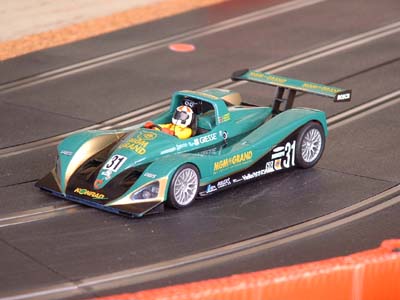
Finally (and by no means least) is the SPIRIT Reynard 2KQ (Telefonica). A newer model to the Fly Lola B98/10, Spirit has come out swinging with this one!!! Spirit has placed this release right in the territory currently occupied by their B98/10 Lola! It's finish, detail and Tampo are on par (or better in some respects) than the Fly Lola, BUT does it have the goods under the svelte and sexy body to get the job done???? The earlier LOLA B2K/10 (all these numbers and letters….) series of models introduced by SPIRIT were a great first attempt in our ''fussy'' market (IMHO anyway). BUT I personally found they didn't have enough go in them to be truly successful against the more established competition.
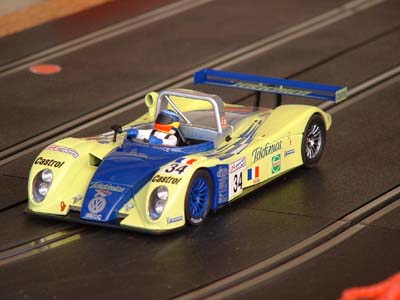
Anyway, enough of the prologue, lets get this show on the road!
MY LAYOUT is a four lane Scalextric Sport circuit, set up to provide a blend of fast and technical sections, which by all accounts makes for some great scale racing. Average lane length is 17.5 meters (approx. 61.25 feet for my American cousins). Our race management program was the Scalextric RMS product, although now we use the YASCART freeware in conjunction with the standard Scaley RMS track hardware. I found the Scalextric software VERY difficult to cope with, and believe YASCART to be miles ahead in both user friendliness and range of functions on offer.
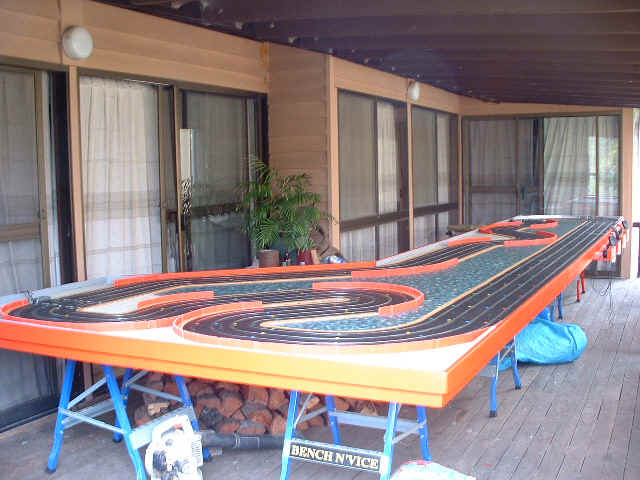
We use the standard Scalextric powerbases, in conjunction with PROFESSOR MOTOR Silver series controllers. Power is supplied via 4 standard Scalextric transformers (wall warts), one per lane. Voltage drop is minimal, but is ever so slightly noticeable at the furthest point from the powerbases. I haven't really worried a great deal about this since constructing the layout, but will probably get around to putting in some power taps to fix it one of these years (it's no big deal to me or the others that make use of the layout for our club racing).
OUT OF BOX TESTING or ''OOB'' is something I always do with a new model for a variety of reasons. Firstly, I give all new models some ''gentle'' track time, just to help everything bed in that little bit more and to get a ''feel'' for any handling characteristics that the chassis may possess. I've found most models offer a different feel, compared to other makes/brands, also some otherwise identical models occasionally differ slightly in on track ''feel''.
After some gentle ''break-in'' laps, I like to give them a good run just to see how they perform in untouched condition. This sets parameters for further tuning, if I make an error in set-up, I have a solid base line to fall back on. I can also ''see'' how a model copes with the layout. This provides a good in-sight into wheels being out of round, guide blades binding in tight radius corners and similar problems that may need attention during the tuning process. I very rarely adjust anything on a model at this stage, the only exception generally being confined to minor adjustments of the braid.
In this Comparison, all models were initially tested in OOB condition (all ran well straight out of the box). The only exception was the SCX Dome Judd, which had its magnet adjusted to suit the rail height of my Scalextric Sport layout. It is a very minor adjustment, very easy to accomplish and does away with a variable that may or MAY NOT suit a particular track system. It is perhaps an advantage initially, but I'm sure all things considered, this small adjustment will be negated further into the tuning process.
TEST PARAMETERS consist of 50 laps on Lane 2 of Millennium Raceway (the fastest of the four lanes). The worst 5 laps are removed and the average lap time is re-calculated. I wanted to create conditions as close to racing as possible, I feel this is the best way to achieve this. Relying on one best lap doesn't give a true indication of performance as far as I'm concerned (I can ''Jag" a good one as well as the next guy). Running the 50 laps in a conservative manner also doesn't do it for me, as this is very rarely the case in actual club level competition. Everyone comes off when they ''push'', so I figure that an allowance of five ''offs'' will cover this boy pretty nicely. I also test on my lonesome, so marshalling adds another variable. I've noticed some models have difficulty with different corners on the layout to others, so an off is an off regardless. It doesn’t seem kosher to penalize one models lap bracket more than another because it (me) has trouble with a corner on the far side of our layout.
I'll give the OOB TESTING RESULTS in reverse order, please bear in mind though, this is only an initial finding. Quite often a model in OOB form responds very well to commonly used tuning techniques, and really shines in race ready form (this has happened so many times for me now, so I don't take OOB performance as a definitive guide to a models worth). Any of the five models in the comparison can be considered worthy of consideration for club racing, they are all worthy contenders.
SCALEXTRIC LISTER STORM LMP Best Lap 5.928 45 Lap Ave. 6.109
I was particularly interested to see how Scalextrics latest addition to their LMP stable performed against the venerable Scaley MG Lola. As mentioned before, I have had a great run with our two Scaley MG Lola's, finding them to be exceptional models. The Lister promises much, due to its innovative new chassis design and attention to detail concerning ''user friendliness'' aimed at the serious club racer.
Unfortunately my sample didn't live up to expectations, being noticeably noisier on track than the MG Lola that it "supersedes". The rattles seem to originate in the front end of the model, quite noticeable to the whisper quiet of the Scaley MG.
The front end lifts under full acceleration, a slight wobble was also noticed (no doubt due to out of round tires, this isn't a major issue). The model exhibited no great turn of pace on our circuit, acceptable but not breathtaking. I also felt the Lister Storm had some quirky handling issues, being very loose in the rear, particularly when going too deep into a corner under brakes (Hey it happens). Direction changes also caused some instability (through esses), which led to what would be termed in motorcycle circles as a "Tank slapper".
In all, I found it very nervous in the handling department, having to concentrate 10/10ths to put in decent lap times, I found no ''leeway'' when trying to get the best from this model.
SPIRIT REYNARD 2KQ Best Lap 5.697 45 Lap Ave. 5.912
This latest offering from SPIRIT is a quantum leap in comparison to their previous Lola B2K/10.
It is everything the Lola should have been. The Spirit Reynard is probably the quietest runner of the lot (Scaley MG Lola would be a very close second). The Reynard oozes quality, a very nice package, providing a well-balanced chassis for the club LMP enthusiast. It can be ever so slightly loose if pushed (I like this feel in a car used for racing), but is a very, very forgiving model.
As noted by other reviewers, the rear tires on my Spirit Reynard were in need of a good sand to true them up, but overall, I felt this model performed well in OOB form.
The motor/drive train combination (10 tooth pinion on this model), provides smooth and positive power delivery (Turbine smooth). Acceleration is brisk, but not brutal (as per one of the models to follow), the top end of the Reynard is AWESOME!!!! To be truthful, our layout probably isn't suited to this car, for it to really shine would require much longer straights than we currently have at Millennium.
FLY LOLA B98/10 Best Lap 5.591 45 Lap Ave. 5.797
As mentioned earlier, I had given FLY models a wide berth until recently, BUT I'm very happy to say this model has restored my faith in the brand name! It's true to say the Fly Lola B98/10 is the noisiest in this field, BUT performance wise it is a CRACKER!!! Acceleration is awesome for a model running a "Stock" type Mabuchi motor (would love to see how it would go with a FLY Blue label Race motor installed). The Fly Lola has a well-balanced chassis, offering a good degree of on-track stability, something, which is quite desirable in a model destined for the club-racing scene.
One problem I did encounter with this car though was the regularity with which the magnet would ''hang up'' on the rail of the next closest lane when driving with that ''tail-out'' attitude some of us love. Not a great problem, a slight adjustment to your (my) personal driving style will minimize this quirk, the trick is to keep it "straight". By this I mean, feeding the throttle on gently off the corner apex, giving full throttle when the model has fully negotiated the curve in question. A conservative approach to running laps works with this car, lower overall gearing plus a light overall weight provides for a lively model!
This isn't a major fault or flaw in model design, I fully expect the FLY Lola to lose this trait after the tuning process (sanding the rear tires to enhance mechanical grip should be all that is needed).
SCALEXTRIC (Sport) MG LOLA Best lap 5.493 45 Lap Ave. 5.699
Well, it just goes to show what a great job Scalextric did when they originally designed this model for the 1/32 slot enthusiast!
In all fairness though, family Wessling has two examples of this model, the Nighthawk racing version (which this one is) and the initial Green/Grey release that HAS seen a lot of use at Millennium Raceway. I am very familiar with the car, having done many serious laps in the Green/Grey version. This model has also been modified in recent times (a small "freshen up"), having a Cartrix TZ Race motor installed along with a set of new compound Indy grips. These minor modifications make the Scaley MG Lola into an awesome performer on our circuit (probably the quickest car currently in our collection).
The ''Nighthawk'' version in this comparison though is dead stock, having been used as a "Benchmark" to evaluate the potential (or otherwise) of models that come into our household. It has had the same gentle break-in laps of the other four contenders, plus some more serious laps, but has not been thrashed, keeping it's ''as new'' appearance both cosmetically and mechanically. Having made this caveat, I am still amazed at the overall performance and quality this model offers. It is stable and forgiving, offering a very balanced feel in regards handling.
It accelerates smoothly and with gusto (albeit not to the same level the Fly Lola!), has a good useable top end, the Scaley MG simply DELIVERS!
The front end WILL lift under hard acceleration, causing some nervous moments on Millenniums main straight, but for the most part is just plain fun to punt around the circuit. This isn't a major flaw, I'm sure that front end truing will fix this small problem (it did with the other one). The addition of the optional Sport button mag in its intended position will also cure this trait, but as club racing in my area doesn't allow for the use of the button mag, its use will be omitted from the tuning process that is to follow in this article.
All in all a great package, it will be interesting to see if the "Journeyman" can keep the newer LMP models at bay after race tuning!
SCX DOME JUDD Best Lap 5.226 45 Lap Ave. 5.438
First points in the OOB test go to the brash young Spanish newcomer to the LMP scene!!!
I never thought I'd see it, little own be saying it, BUT SCX have come up with a fantastic package with the Dome Judd!
It's fair to say that I have been a little critical of SCX over the last couple of years. Here in Australia, SCX models are both cheap and plentiful, perhaps being the most common brand found stocking shelves of non-specialist Toy and hobby retail outlets.
Quality and price? I had my mind made up prior to purchasing the Dome Judd that SCX offered beginners a starting point in which to enter our hobby, with little else to offer the more serious hobbyist.
How wrong could I have been? The Dome Judd offers stunning on track performance AND at the right price (for we Aussies anyway). It's true to say that the overall package of the SCX Dome Judd isn't quite as polished as it's more expensive competition, BUT at around 1/2 the price of a FLY model in OZ, this model represents great value to the club racer.
The price is right, and so is the performance. It is relatively quiet, exhibiting a small amount of gear noise, but is a vast improvement over earlier SCX models that I have in our small fleet of 1/32 cars. It's smooth, with perhaps the faintest trace of a shudder from the front wheels (easily fixed during tuning). The adjustable magnet is also a brilliant feature, making the DOME JUDD an ideal basis for a club car, particularly if you race on different track systems. It's so easy to adjust magnetic downforce to suit varying rail heights and track surfaces, making easy work of fine tuning before going out to do battle on an unfamiliar layout.
I did adjust the magnet prior to OOB testing, probably not exactly out of box issue, BUT the procedure was so quick and easy I really couldn’t help myself!!! I'm sure the results after tuning will swing back towards the other models in this comparison, so I figure all will be even after tuning.
On track, the SCX Dome Judd doesn't seem that quick (thanks in part to the heavy magnet feel), but when the lap summary is viewed, this is one fast and consistent chassis for magnet racing.
The SCX motor exhibits good torque, giving a similar feel to the Ninco NC-2 type Mabuchi (although not as good in my opinion, the NC-2 is a VERY good stock motor). Having said that, it does cope with the heavy magnet configuration quite well, with no noticeable drop off in performance towards the end of a fifty lap bracket (something I was half expecting).
As with most things in life, you can't have your cake and eat it too, as is the case with the Dome Judd. Due to the hefty magnetic downforce, the model has no great top end performance, simply content to lumber around the circuit and complete its task with the minimum fuss.
I like this model, I love what it offers to enthusiasts, it isn't my favorite (yet), but I've come to respect the effort SCX has put into providing a model that offers this level of performance to the serious 1/32 hobbyist.
WITH OOB TESTING completed it is now time to break out the Dremel and other essential "tools" of the slot tuners "trade" to see how these models respond to some judicious TLC!!! The final proof of the pudding is in the eating (as Mum always used to say), I get the feeling that we are in for a RIGHT ROYAL FEAST…….
TUNING PROCEDURES used for the test (and all models I use in competition) are very straightforward, being covered in more detail in other parts of the HOME RACING WORLD website.
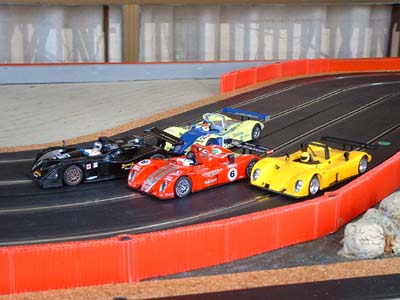 None
of the models in question were "perfect", BUT they were all very good regarding
tolerances, trueness and concentricity. The SPIRIT Reynard was first cab off
the rank for some attention. I found the axles, axle to bushing fit and gear
mesh alignment to be first rate. I can't recall seeing a model as good in these
areas as the Reynard. However, I did have problems with the tires being our of
round (most are to some degree, but the Reynard was a little ordinary in this
aspect). I also found the rims were in need of a good true to gain best
possible concentricity. This led to a small problem regarding how the tires sit
on the rims. I personally prefer a tire that slips firmly over the rim,
negating the need for adhesive to keep it in place. This was not possible to
achieve with the Reynard after truing, so I sparingly applied a small amount of
LOCTITE 480 (Black Max). Total overkill regarding bonding strength, BUT if
applied very lightly it dries black, doing away with the unsightly white marks
that regular Superglue sometimes leaves. I would suggest SPIRIT look into
reducing the Inner Diameter of their tire moulds and/or increasing rim rib
height.
None
of the models in question were "perfect", BUT they were all very good regarding
tolerances, trueness and concentricity. The SPIRIT Reynard was first cab off
the rank for some attention. I found the axles, axle to bushing fit and gear
mesh alignment to be first rate. I can't recall seeing a model as good in these
areas as the Reynard. However, I did have problems with the tires being our of
round (most are to some degree, but the Reynard was a little ordinary in this
aspect). I also found the rims were in need of a good true to gain best
possible concentricity. This led to a small problem regarding how the tires sit
on the rims. I personally prefer a tire that slips firmly over the rim,
negating the need for adhesive to keep it in place. This was not possible to
achieve with the Reynard after truing, so I sparingly applied a small amount of
LOCTITE 480 (Black Max). Total overkill regarding bonding strength, BUT if
applied very lightly it dries black, doing away with the unsightly white marks
that regular Superglue sometimes leaves. I would suggest SPIRIT look into
reducing the Inner Diameter of their tire moulds and/or increasing rim rib
height.
The SCX Dome Judd was about as straightforward tuning as you could want. Overall tolerances were good, wheel concentricity very good (A pleasant surprise from other SCX models I've worked on!!!). The tires needed a little work, BE CAREFUL when truing this type of SCX rubber. It is very pliable, run your Dremel at a lower speed than normal and take your time! Rush it and you could easily end up with a tire that has a "corner" cut into it. Also remember to adjust the chassis magnet UP a fraction to allow for the slightly lower tire height after truing…..
The FLY LOLA was well above average, very well put together, about the only thing I noticed amiss with my example was that the rear axle to bushing fit was a little on the sloppy side. Again, watch the tires when truing (especially rears). FLY uses tires don't take kindly to using coarse sandpaper at higher RPM, better off using a slower speed setting and finishing off with some 1000 grit wet and dry.
As with most models in the Scalextric Sport series, the MG LOLA was found to be of a high standard regarding trueness of mechanical components. I did note that the crown gear was ever so slightly Elliptical and the tires, whilst reasonably true, had a poor fit to the rims (as per SPIRIT REYNARD). No major problem, just a minor point I'd like to see addressed in the future…….
Finally, the "BANE" of my life, the Scaley Lister Storm LMP! A more technically advanced model than many of the others in the comparison, with a corresponding increase in the amount of screws and loose bits and pieces flapping around whilst stripped down. I think it's probably a case of me not being familiar with the layout (as all of us would be when pulling one down for the first time). Once sorted out though, I found everything to be in order, the only exceptions being the tire/rim fit as per the Scaley MG Lola and one front tire being some 3/4 of a millimeter HIGHER than its partner. ALWAYS check the O.D. tire diameter when truing your tires, I've found similar in three SCALEXTRIC products now (this one plus rear tires on a Scaley Trans Am and a Williams F1).
FINAL TESTING was carried out as per prior OOB. testing. Clean track, similar conditions overall, results should be indicative of improvements made during the tuning process.
SCALEXTRIC LISTER STORM LMP Best Lap 5.540 45 Lap Ave. 5.671
Tuning this model helped smooth out its on-track performance to a fair degree in comparison to the OOB findings. The Lister Storm still exhibited traces of the "tail out/tank slapper" when pushed, but judicious application of the throttle helped it to turn in respectable lap times and a decent overall average lap time. Front end "lift" was also eliminated during the tuning process. The inability to keep the "hammer down" for the maximum amount of time is what hurt this model the most (car speed is vital). Don't get me wrong, this isn't a BAD model, it runs well, its just the other "contestants" have a better balance in stock form. To my mind the problem lies in several areas, overall weight, weight distribution behind the rear axle (more than any of the other four models tested) and the use of a "Bow-tie" type magnet. I agree with the theory behind this style of magnet for fast/open layouts, but for technical circuits, I feel that nothing beats a good bar magnet (maximum magnetic grip over the rails) for this style of racing. Having said this, Scalextric have made provision for a bar magnet in the forward position in the chassis molding of this model. If your local club rules allow leeway for any changes in this area, I feel that the Scalextric Lister Storm would truly shine!
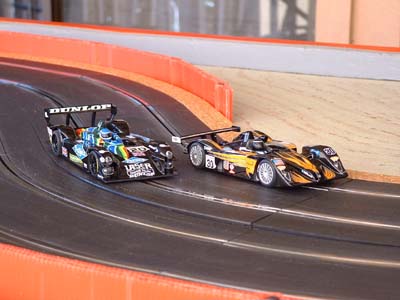
SCALEXTRIC (Sport) MG LOLA Best lap 5.093 45 Lap Ave. 5.318
The current LMP champion defeated? Well it’s a matter of personal opinion I suppose.
This model was brilliant and STILL IS a credible contender for club level competition. Very smooth and deceptively fast, the Scaley MG LOLA can still hold its head high in the midst of the current generation of 1/32 scale LMP cars. Tuning smoothed the whole package out, providing for some very enjoyable (and quick!) laps around our layout. Front-end lift was still noticeable, but no-where near as bad in OOB form. The only real negative I could find with this car is the "ease" in which the guide "pops" during a solid off. There are ways to minimize this trait (the norm for this style Scaley guide), it's something that any serious club racer knows can cost him lost time during the course of an event. I've found that a little pre-race turn Marshall education goes a long way to lesson the effect of this small but niggling fault with the old style guide system. I suppose it’s a case of the old adage, "You shouldn't have come off the track anyway!"……
SCX DOME JUDD Best Lap 5.063 45 Lap Ave. 5.221
As I expected from earlier OOB testing, no great gains in overall performance with the SCX Dome Judd (thanks to it's nifty little adjustable magnet pod). This model is a huge leap forward for SCX, placing it well and truly in the "performance" niche of our hobby. I love the Dome Judd, it’s a good honest model with no vices, very stable, very predictable.
It offers the atypical heavy magnet chassis feel to it, love it or hate it, this model delivers the goods for magnet/plastic track. I personally prefer a livelier set-up in this regard, mainly due to the "flexibility" gained under racing conditions (it is sometimes advantageous to have a little more poke on tap to pull a quick gap or break the tail loose). The SCX Dome Judd just trundles around the layout, racking up quick and CONSISTENT lap times with the minimum fuss. If your local club rules allow, perhaps a change to the SCX Pro-Turbo motor MAY offer some improvement (it does with older SCX motors, but this one and the Jag F1 seem to be quite OK in standard form). It isn't something I've looked into yet, SCX motor specification listings seem to be a bit of a "Dog's Breakfast" from what I've heard, but it'd be interesting to try both motors back to back and see if the Pro-Turbo is the stronger unit.
SPIRIT REYNARD 2KQ Best Lap 4.721 45 Lap Ave. 4.870
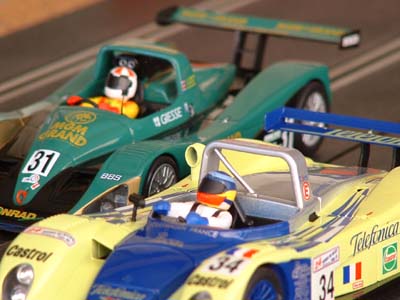 WOW,
I've said it before and I'll say it again here, SPIRIT has come a long, long way
in such a short time!! The first modern LMP offering from SPIRIT (LOLA B2K/10)
was no ball of fire, BUT it was a credible first effort in the 1/23 scale slot
scene. It seems SPIRIT has built on their initial efforts and for the most part
have got the package right (my small niggle about the wheels and tires on this
model).
WOW,
I've said it before and I'll say it again here, SPIRIT has come a long, long way
in such a short time!! The first modern LMP offering from SPIRIT (LOLA B2K/10)
was no ball of fire, BUT it was a credible first effort in the 1/23 scale slot
scene. It seems SPIRIT has built on their initial efforts and for the most part
have got the package right (my small niggle about the wheels and tires on this
model).
Out of the five models tested, I felt most comfortable with the SPIRIT Reynard, it seems to suit my style of driving to a tee. It is incredibly sure footed (very hard to put a foot wrong with this model on our layout). The motor that comes standard with this model is a "stonker", pulling the higher gearing with ease, making for a great balance of good acceleration and a scintillating top end. The taller gearing also offers another advantage for racers like me that prefer a little less braking effect. I like to "flow" a car more through corners and often find it difficult to accurately judge braking points with the extra retardation that shorter gearing provides.
All in all, very sharp, very crisp, a great overall package. I doubt very much if any enthusiast will be disappointed if they buy a SPIRIT Reynard for their collection, or for serious club racing!
FLY LOLA B98/10 Best Lap 4.618 45 Lap Ave. 4.725
THE KING IS DEAD, ALL HAIL THE KING! Dramatic? Yes, it is quite a statement, but as far as sheer performance on our layout goes, the FLY LOLA B98/10 is KING!
After tuning, this model (along with the Reynard) really let its fine qualities shine through for all (especially a self-confessed FLY skeptic!) to see. My previous OOB concerns regarding the rear end losing grip, letting the magnet pick up the rails in the next lane were virtually cured (only happened once after the tuning process). Magnet is great, but to make a really good runner in this style of racing, mechanical grip via quality rear rubber is essential.
FLY has created a chassis that offers excellent stability and handling qualities for LMP club racing (for those that haven't already "savored" this fine model). The gearing of the FLY Lola is just about ideal for Millennium Raceway, virtually "tailor made" for the job at hand. The gearing also provides fantastic acceleration, being very "punchy" out of the corners, you can virtually see this model hook up and lunge forward when coming off the corner apex! I felt very comfortable punting the FLY Lola around our layout, perhaps not quite as forgiving as the Spirit Reynard (in fact the FLY offering use up a few more of its "get out of jail free" laps than the SPIRIT). Never the less, the proof is in the pudding, and the FLY LOLA did the job on the day (and within the testing parameters). Great work FLY! The model on test is actually my eldest daughter, so I think I'll be shopping for another Fly Lola B98/10 for me in the not to distant future!!!!
MY CONCLUSIONS for this comparison aren't as straightforward as the performance figures would suggest.
Firstly let me say, there isn't a "Bad" model amongst the five, all ran well, and will provide hours of total enjoyment for any enthusiast fortunate enough to own one. I must admit that the SCALEXTRIC LISTER STORM was something of a disappointment to me personally. I was expecting a marked improvement in performance over their previous effort (Scaley MG Lola), but this never materialized during extensive testing. The Lister Storm has got some great features included in the package, and for those of us that run in modified classes of racing, there is definitely a great amount of "development" potential factored into its design.
The SCALEXTRIC MG LOLA will always hold a "special" place in our LMP "fleet" here at Millennium Raceway. It was an OUTSTANDING model when initially released regards performance, fit/finish, they always have been a quality offering. We have all shared MANY hours of fun with this model, it has always been the "one" that everyone grabs off the shelf when they want to run some fast practice laps. On track performance is still acceptable (to me anyway), I feel that the inclusion of the optional "Sport" button magnet would put this model back up with the front-runners. Over here in my neck of the woods the use of the Sport button magnet isn't permissible in club competition, hence my reason for not including it in this test. However, if your local club permits its use, GO FOR IT, using it will reduce or stop the tendency for the front end to lift as mentioned previously.
The SCX DOME JUDD made a great impression on me. It doesn't possess the ultimate verve of its Spanish brethren, but it has many positive features. If you are interested in owning a model that will run quick out of the box, this is the one for you (Guys, remember some of us don't have the time/inclination to get carried away with race tuning models). The Dome Judd is a model ideally suited to the new/novice enthusiast, being very consistent thanks to the amount of magnetic grip the unique magnet adjustment pod provides. This pod is also an advantage to those of us that run on different track types (rail heights) during the course of a seasons racing in larger club scenes. It is so easy to "dial-in", taking no time at all to achieve. I also suspect this model would do well on routed board layouts, thanks to the milder motor included in the package (routed board layouts DON'T need huge power to make a competitive car, chassis balance and mechanical grip being more important)…..
AND did I mention the PRICE ADVANTAGE (of course I did, BUT I want to mention it again, OK?)??? After all this is something near and dear to my mixed Dutch/Lutheran heritage!. Over here in Australia, the SCX DOME JUDD can be had for as little as $33.00AUD plus postage. In comparison the FLY LOLA costs approximately $80.00AUD plus post, two (and a bit) for the price of one is one MAJOR reason to seriously consider this model for serious club work (for this boy anyways!).
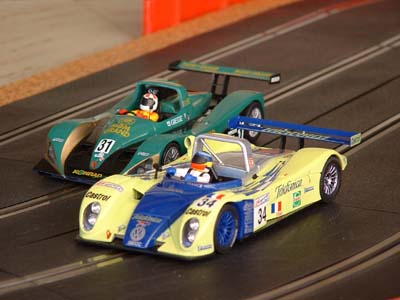
Which leaves us finally with the top two LMP cars in this five-car comparison. Both are so close in overall performance and quality of build it isn't funny. The FLY as previously seen IS the winner regarding outright performance, BUT for me personally, if I had to choose between the two, I'd go with the SPIRIT REYNARD.
The Reynard is ever so slightly more consistent for me on our layout, I prefer the "feel" of it just that little bit more to the FLY LOLA. It is on average a tenth of a second a lap slower than the Fly Lola, but I think I'd be willing to live with the disparity considering the SPIRIT Reynard gives me a higher level of confidence to punt hard in the crucible of club competition. An ethereal reason to base my choice on? Yes and no. It’s a matter of personal preference, I've often found that the best/fastest/most accurate piece of equipment doesn't always take the prize at the end of the day!
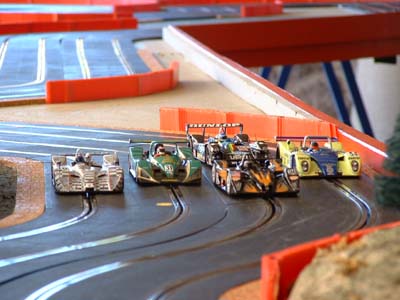 I
also suspect that the Spirit Reynard will come into its own on a larger/more
open layout than Millennium Raceway thanks to its taller gearing. Another
consideration to take into account for those of us that use aftermarket power
supplies is the (obvious) quality of the motor used in the SPIRIT Lola. It
handles the taller gearing with ease on our layout (standard Scaley wall warts),
I feel that more amps will really make this little sucker shine!!!
I
also suspect that the Spirit Reynard will come into its own on a larger/more
open layout than Millennium Raceway thanks to its taller gearing. Another
consideration to take into account for those of us that use aftermarket power
supplies is the (obvious) quality of the motor used in the SPIRIT Lola. It
handles the taller gearing with ease on our layout (standard Scaley wall warts),
I feel that more amps will really make this little sucker shine!!!
The FLY LOLA B98/10 has won the "battle" at Millennium, BUT I think the SPIRIT Reynard could win the WAR!
- Rob